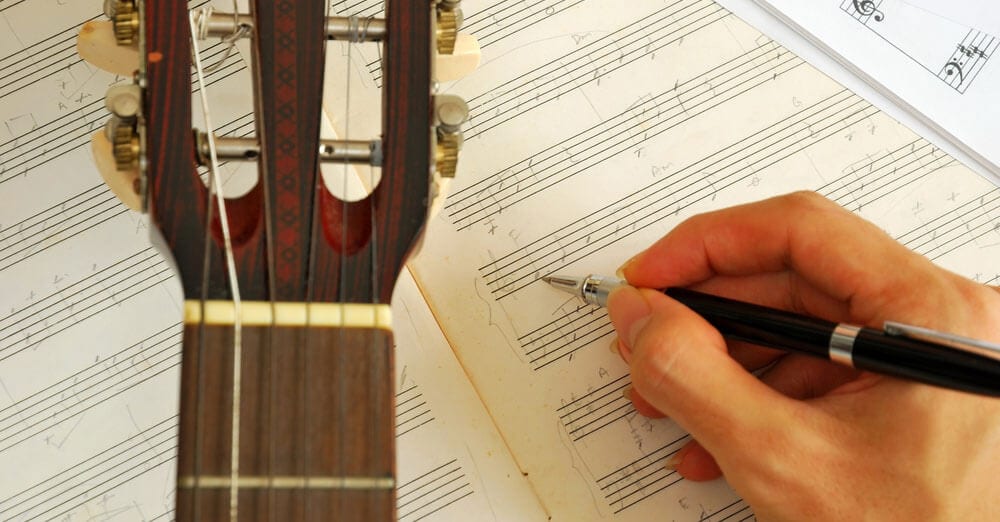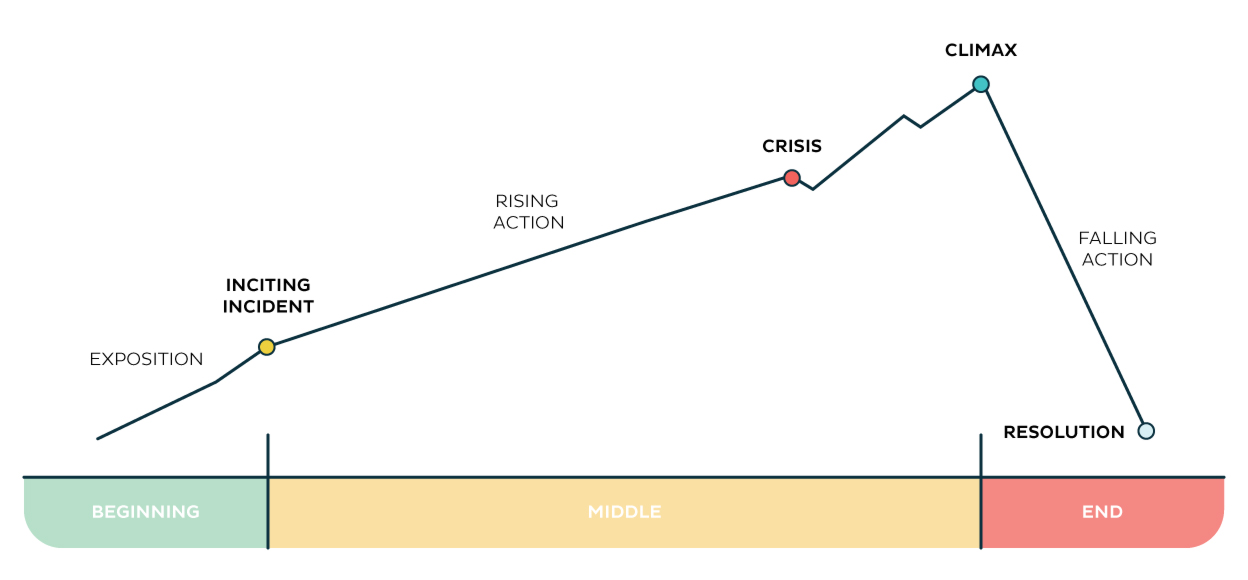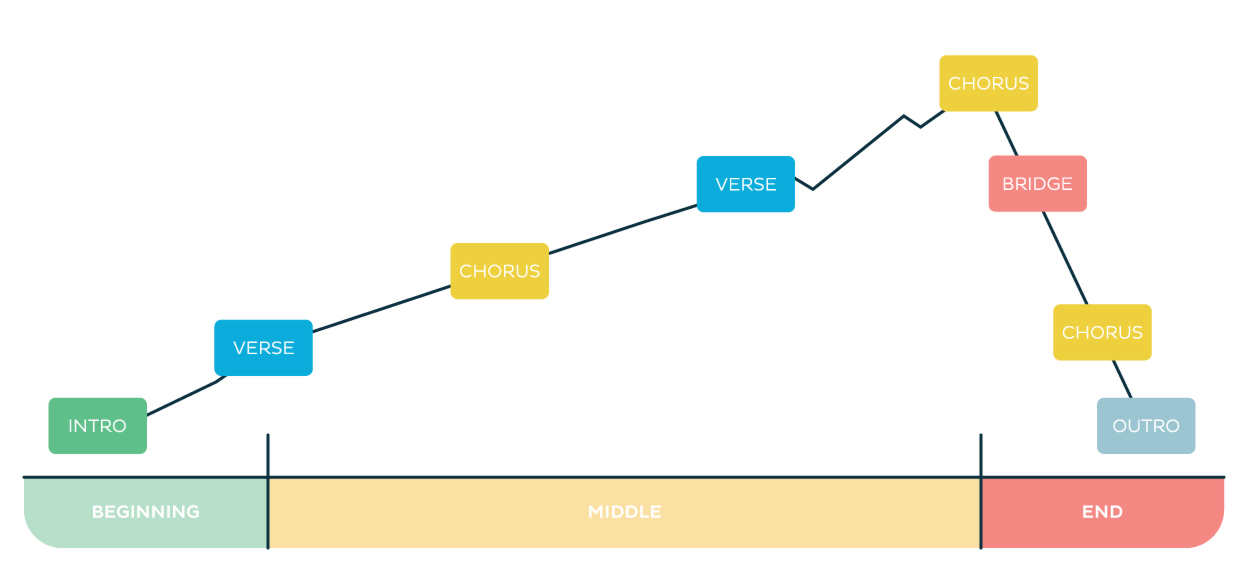Continue with some last steps to write a song that gain more fans…
4. Choose your song structure
Now that you have discovered your main track idea, and you understand the song form basics it’s time to beef it up a bit.
Your central idea is a stepping stone to the rest of your track. In this part, you will learn how to turn your rough draft into a structured track.
The best track structure for your project will all rely on what type of music you’re writing.
For instance: when you are writing a pop song, your structure will vary slightly compared to writing an EDM track.
However, there are basic structures that apply to most prevalent music these days.
Song structure
There are obviously lots of how to arrange a track. How you arrange yours is up to you. However, there are common song structures that are great to work with when you are just starting out.
The most common music structures are:
The best song structure to begin with
The most important parts to begin to write a song are your verse and chorus. Get to know these first then move on to other sections.
Once your ready, it is time to fill out the rest of the structure. There is one structure that’s easy, simple and provides songs a great sense of narrative and suspense.
It makes your ears beg for certain parts. It takes you on a little song journey. It’s the structure that defines catchy.
It goes:
Pretty easy right?
You may be thinking to yourself “most songs are in that structure? Well, that’s boring.” However, the reality is, this structure leaves lots of room to create in.
There are infinite sounds to put into this track form. So experiment with each part to make it work for you.
EDM song structure
EDM track structure works in the same method to the structure I talked about above, however with a few changes.
It goes:
These sections work even without lyrics. A chorus does not need vocals. Make it a catchy repeated synth lead instead.
EDM has lots of room to work within the common track structure.
Perhaps your song will have a thumping bass line via the whole track that never changes. However, the parts on top shift and change.
Or you could keep your lead the same and turn your percussion sections into a verse, chorus, and so on. It is up to you how you work inside the form.
5. Build from song ideas
Okay, now that you understand the parts of a track and track structure it’s time to begin writing!
Is your sketch a sweet hook? Then it’s time to determine where it fits. It can be in the chorus or even the bridge.
Is your rough track idea a few perfect lines of lyrics? Select where they will go. Perhaps they will fit in the second verse.
No matter where you decide to place your first idea, deciding where it fits in your structure will assist you to build around it.
For instance: when you use your main idea to build your first verse, then it is simpler to flow into the first chorus. Each part is a stepping stone that results in the next.
So drop your doodle somewhere and begin building!
6. Finishing a song
So now you have your track idea in place, you understand all of the parts you want and you have picked a structure. Superb.
At this point, there are infinite methods to achieve the finish line. It is the magic that makes songwriting so particular: there’s no ‘greatest’ method to do it.
“You could not say ‘how do you write a song?’ It just comes out. Everybody has their own process.”
-Bruce Roberts
In terms of songwriting, Bruce Roberts can’t be more right. The most effective songwriting process is YOUR OWN process.
The only method to figure it out is to take time, sit down and build it. Hopefully, there is a lock on your studio door!
Keep in mind that it will not always be simple. Generally, songs flow right out. Other times they want some coaxing.
When you get stuck or are feeling lost there is a whole heap of songwriting ideas that may assist you to get over the hump.
Songwriting exercises
These songwriting exercises will assist you to get over creative blocks, build ideas, and stay inspired.
- Imitate. Then make it your own
Timeless songs final for a reason. The best way to write a song is to listen to how the greats did it.
“Good songs take on different meanings and different lives forever.”
-Diane Warren
Listen to your favorite track and ask yourself what makes it so great? How is it arranged? What are the parts? Hum the melody, or better yet play it!
After you have a great understanding of it, attempt to create your own melody that matches. When you begin with the best and then riff on it, chances are you are gonna wind up with gold.
Like Tom Waits’ trick. He plays 2 different radio stations at once and listens for fascinating overlaps.
Or Bob Dylan’s process. He begins every songwriting session with a few minutes of deep meditation while listening to a track that inspires him.
There is a whole world of weird songwriting tips out there that legendary musicians swear by.
Keep in mind, there is a difference between inspiration and ripping someone off. Get influenced, however, always make it your own.
So listen to the greats and you will have lots of concepts to roll off in no time flat.
- Use the narrative arc
Keep in mind in grade school once you’d have to memorize all of the parts of a story? Like ‘rising action’ and ‘climax.’
Or perhaps you were not paying attention cause you were too busy listening to your mini-disc.
Either method, songs are stories. Applying the narrative arc to your songwriting is an ideal method to make your track more fascinating to the listener.
Use each section to create suspense. Build your track up to a climax. Hint at certain parts developing to keep the listener glued to the headphones.
The narrative arc looks like this:
Applying the narrative arc to a common track structure would look something like this relying on your parts:
- Active listening
Another method to use your influences is to map out how your favorite track works. You should know how to use active listening to do it.
Grab some paper and a pen. Make a diagram of a song that resonates with you. Attempt to jot down each a part of the music that I mentioned before–verse, chorus, bridge, and so on.
It will assist you to image the structure of your favorite track in a visual method.
Hot Tip: If I really wanna understand how a track works, I sometimes put it in my DAW software and slice the waveform up into each distinct part.
Not only do you see each part, but you could also ollow the waveform to see how the dynamics work in each section.
Then I color code each part to know which part is which. As the play cursor moves along I look and listen to see where each part changes to the next.
It’s like Where’s Waldo? for music. Except it’s more of a ‘where’s the nuggets?’ type of thing I guess. However, once you determine the parts it’s method simpler to make them on your own.
- Think of your song as pieces of a whole
Once you write a song it’s simple to get lost in the pieces.
Obviously, it’s vital to concentrate on each part. However, bear in mind to keep the large image in mind. When you are stuck use the parts you hâve already written as a reference.
The parts of your track should all fit together in an organic method. Let each part inform the next one. When you zoom in on each part too much the pieces could begin to get disjointed.
Keep in mind, you aren’t writing a hook, a chorus, and melody. You are writing a SONG! Each element has to fit properly for it to sound good.
So make your track sections with the other parts in mind and everything will fit like peas in a pod.x
- Find your songwriting partner
Think Jimmy Page and Robert Plant, Mick Jagger and Keith Richards, John Lennon and Paul McCartney. The list goes on…
Get a collaborator. I do not know about you, but personally, the thought of being locked away alone in a room trying to write a song sounds pretty difficult.
Partners are excellent for pitching parts or bouncing ideas off of. Plus 2 or more people means at least twice the ideas. And twice as quick at finishing.
When you have already been writing songs a partner will also spice up your sound a bit by bringing new sounds to the table. To collaborate and double your songs!
- Think like a listener
You know what the best way to find out in case your track is great or not? Play it!
During the songwriting process, it is super simple to get lost in your sections. Or lost in diagrams and arrangements.
Check your track usually and just listen. Playing a part you are stuck on usually leads you to that next note because your brain automatically desires to hear that next part.
It wants progression and wants to fill in the pattern organically. So play what you have got as much as you could while you are writing.
It may even mean repeating the same part again and again. However, most times you will be surprised how fast these roadblocks all just fade away…
One song is never enough
Now that you have all of the tools you should write a song there is one thing left to do:
Write a ton of songs! The only method to become a great songwriter is to write all. the. time.
“Just keep doing it. That’s how you get good. That’s how you get great, and stay great.” -Diane Warren. Grammy Award winning, multi-platinum songwriter.
A great rule of thumb is to have a song on the go at all time. Or better yet have 3.
In terms of learning more is always better. Let yourself fail. Let yourself succeed. Know when to say yes and when to say no.
With these songwriting tools, anything is possible. Your next great song just needs that one last vital ingredient:
The doing. Just never give up!









